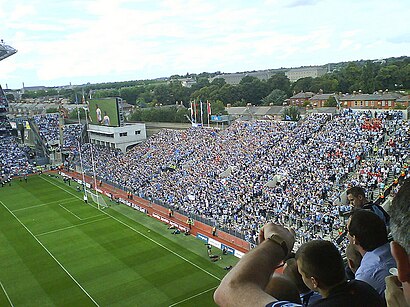See Hill 16, Dublin, on the map
Directions to Hill 16 (Dublin) with public transportation
The following transit lines have routes that pass near Hill 16
Bus:
Train:
How to get to Hill 16 by Bus?
Click on the Bus route to see step by step directions with maps, line arrival times and updated time schedules.
How to get to Hill 16 by Train?
Click on the Train route to see step by step directions with maps, line arrival times and updated time schedules.
Bus stations near Hill 16 in Dublin
- Summerhill (Dublin City), Sean O'Casey Estate,15 min walk,
Bus lines to Hill 16 in Dublin
- 123,Marino,
What are the closest stations to Hill 16?
The closest stations to Hill 16 are:
- Summerhill (Dublin City), Sean O'Casey Estate is 1047 meters away, 15 min walk.
Which Bus lines stop near Hill 16?
These Bus lines stop near Hill 16: 14, 32, 46E, 7A
Which Train lines stop near Hill 16?
These Train lines stop near Hill 16: DART, MAYNOOTH SERVICE
What’s the nearest bus stop to Hill 16 in Dublin?
The nearest bus stop to Hill 16 in Dublin is Summerhill (Dublin City), Sean O'Casey Estate. It’s a 15 min walk away.
See Hill 16, Dublin, on the map

Public Transit to Hill 16 in Dublin
Wondering how to get to Hill 16 in Dublin, Ireland? Moovit helps you find the best way to get to Hill 16 with step-by-step directions from the nearest public transit station.
Moovit provides free maps and live directions to help you navigate through your city. View schedules, routes, timetables, and find out how long does it take to get to Hill 16 in real time.
Looking for the nearest stop or station to Hill 16? Check out this list of stops closest to your destination: Summerhill (Dublin City).
Bus:Train:
Want to see if there’s another route that gets you there at an earlier time? Moovit helps you find alternative routes or times. Get directions from and directions to Hill 16 easily from the Moovit App or Website.
We make riding to Hill 16 easy, which is why over 1.5 million users, including users in Dublin, trust Moovit as the best app for public transit. You don’t need to download an individual bus app or train app, Moovit is your all-in-one transit app that helps you find the best bus time or train time available.
For information on prices of Bus and Train, costs and ride fares to Hill 16, please check the Moovit app.
Use the app to navigate to popular places including to the airport, hospital, stadium, grocery store, mall, coffee shop, school, college, and university.
Hill 16 Address: Saint Josephs Avenue street in Dublin

Attractions near Hill 16
- Cusack Stand
- Jones' Rd
- Gaa Museum
- Croke Park
- Etihad Skyline
- Hogan Stand
- Corn Mill
- Davin Stand
- North Richmond Street Industrial Estate
- Araby House
- Irish National Organisation Of The Unemployed
- The Distillery
- Phoenix Tyres
- Printwell Deisgn (Moved To Church Street East, North Wall)
- O'Connell Secondary School
- Royal Canal
- Clonliffe Square
- Communications Workers Union
- Drumcondra South B Ed
- Margaret'S
How to get to popular attractions in Dublin with public transit
- Ballyfermot, Dublin
- Ballymun, Dublin
- Radisson Blu Hotel & Spa, Galway, Galway
- Dcu, Dublin
- Apple
- Microsoft Ireland, Dundrum
- Dundrum Luas, Dundrum
- Limerick institute of Technology (LIT), Mayorstone
- Limerick / Luimneach, Henry Street
- Blanchardstown Shopping Centre, Blanchardstown
- Guinness Storehouse, Dublin
- IBM Technology Campus, Blanchardstown
- Trim Castle, Trim
- Dún Laoghaire Harbour
- Liffey Valley Shopping Centre, Palmerston West
- O'Connell Street, Henry Street
- IBM European Digital Sales Centre, Blanchardstown
- Swords / Sord Cholmcille, Swords Village
- Sandymount Strand, Dublin
- National Botanic Gardens, Dublin